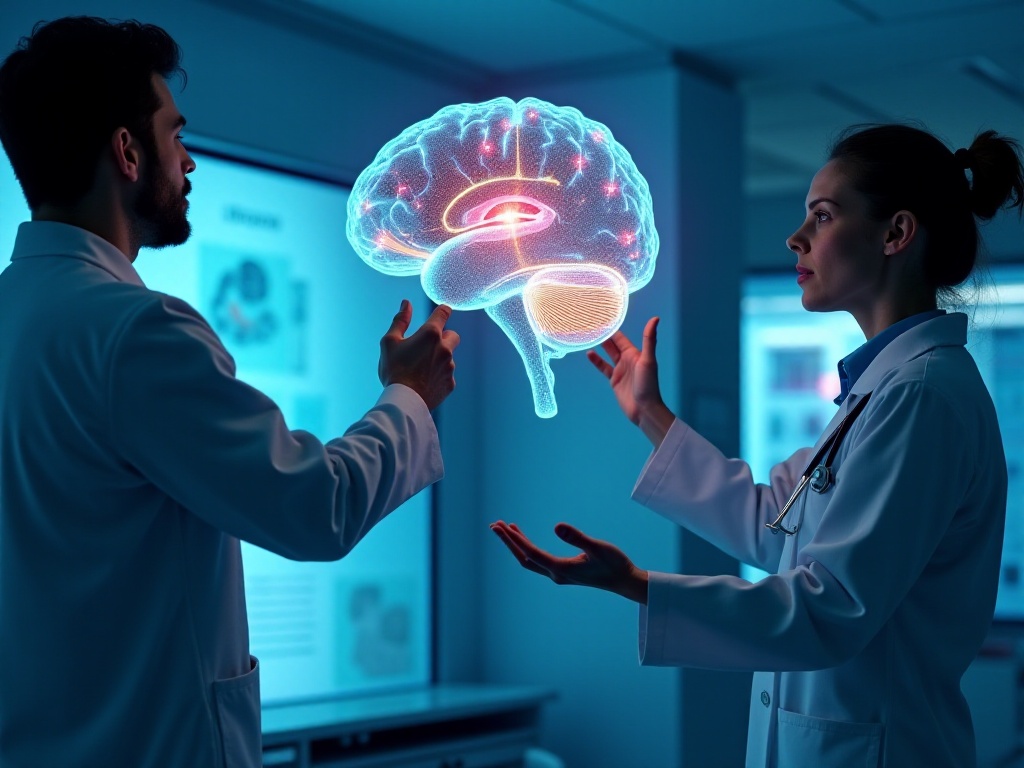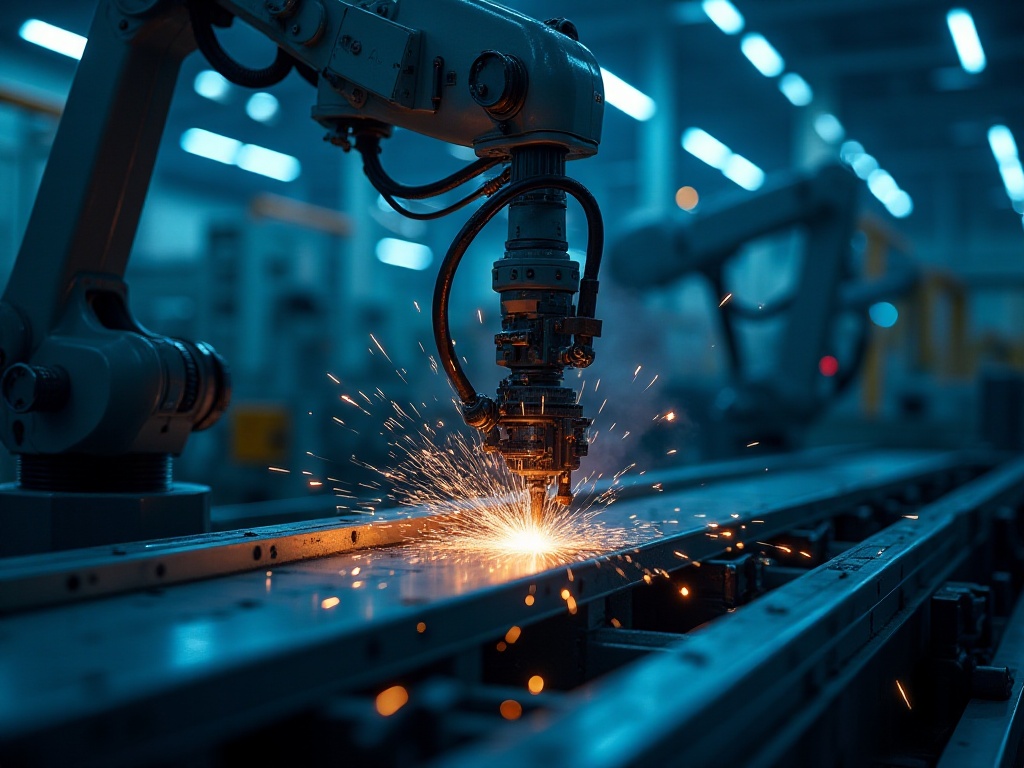Medical AI
Did you know? In recent years, artificial intelligence has made remarkable progress in the medical field. Let me share a true story: In early 2023, during a routine physical examination of my friend, an AI-assisted diagnostic system helped doctors discover an early-stage lung nodule that could have been easily missed in routine checks. This sparked my intense interest in AI applications in medicine. Later, when I learned about this system, I discovered it could complete scanning and analysis of entire CT images in just a few minutes, marking all suspicious areas - the efficiency was truly astonishing.
Not just my friend, I've heard many similar cases. For instance, last year at a top-tier hospital in Beijing, an AI system helped doctors detect early-stage pancreatic cancer in a patient. It's worth noting that pancreatic cancer often has no obvious symptoms in its early stages and is known as the "silent killer." Without AI assistance, such early lesions could easily have been overlooked. These cases made me deeply realize that AI not only improves diagnostic accuracy but, more importantly, helps doctors detect subtle changes that the human eye might miss.
Image Diagnosis
In medical imaging diagnosis, AI's performance has been quite impressive. Microsoft's InnerEye project is a great example. This project can analyze medical images like CT and MRI scans within seconds, achieving an astounding accuracy rate of over 95%.
Speaking of the InnerEye project, I must mention some of its amazing features. First, it employs cutting-edge deep learning technology, training models by analyzing millions of medical images. These images come from medical institutions worldwide, covering various types of lesions. Through continuous learning from these cases, the system gradually mastered the ability to identify various pathological changes.
More impressively, InnerEye can not only identify tumor location and size but also track tumor growth changes. It's like giving doctors a pair of tireless eyes that work 24 hours non-stop. For example, when doctors need to compare CT images of the same patient from different periods, InnerEye can automatically calculate tumor volume changes and generate detailed progress reports. This precise quantitative analysis is particularly important for evaluating treatment effectiveness.
I once spoke with a radiologist who said that with AI's help, he can now focus more energy on analyzing complex cases. Since AI systems can complete preliminary analysis of relatively simple screening work, he can concentrate more on situations requiring clinical experience judgment. This human-machine collaboration model greatly improves work efficiency.
Moreover, AI applications in image diagnosis continue to expand. Beyond traditional CT and MRI images, AI can now analyze X-rays, ultrasound images, and even pathological slides. In pathological diagnosis, AI systems can automatically identify cellular morphological features, helping doctors grade cancers. This technology has played an important role in diagnosing common cancers like breast and lung cancer.

Disease Prediction
In disease prediction, AI applications are even more impressive. For instance, the AI system developed by KenSci can predict potential future health problems by analyzing patients' medical history, lifestyle habits, and genetic information. Statistics show that this system has achieved a prediction accuracy rate of 87%, which is truly remarkable.
I find the way this system predicts diseases most fascinating. It doesn't simply look at a single indicator but comprehensively analyzes various patient information. For example, it considers factors like the patient's age, gender, family history, lifestyle habits, exercise patterns, and dietary preferences. It even incorporates factors like work stress and sleep quality into its analysis.
Through analyzing this massive amount of data, the system can discover correlations that human doctors might miss. For instance, it might find that certain seemingly unrelated symptom combinations actually indicate risks of specific diseases. This predictive capability is particularly valuable for chronic disease prevention and control.
More impressively, the system can provide personalized health advice based on specific patient conditions. For example, if the system detects diabetes risk in a patient, it will suggest adjusting diet structure, increasing exercise, and regularly monitoring blood sugar. These recommendations are derived from big data analysis and are highly targeted.
In healthcare resource management, AI applications are also widespread. It not only predicts diseases but also helps hospitals identify fraudulent medical claims. In the United States, annual losses due to medical fraud amount to tens of billions of dollars. With AI system assistance, hospitals can increase fraud case detection rates to over 90%.
This achievement is truly remarkable. AI systems can quickly detect abnormal patterns by analyzing medical records, bills, and claim documents. For instance, if a doctor's prescription rate for certain medications is significantly higher than the peer average, or if a patient has duplicate examination items at different hospitals, the system will raise an alert. This not only saves medical resources but also reduces healthcare costs.

Practical Applications

Clinical Diagnosis
In clinical practice, AI applications have become quite common. Many hospitals now use AI-assisted diagnostic systems that can quickly analyze patients' symptoms, test results, and imaging data to provide diagnostic suggestions to doctors.
Speaking of this, I want to share a specific example. Last year, I visited a smart hospital where they used an AI-assisted consultation system in their outpatient department. When patients describe symptoms, the system automatically records and analyzes key information, then recommends possible diagnostic directions and necessary examination items based on symptom combinations. This greatly improves consultation efficiency and reduces the possibility of missed diagnoses.
What impressed me more was that this system learns and updates. Whenever doctors confirm or correct the system's diagnostic suggestions, this information is recorded to improve the system's accuracy. It's like a continuously growing medical expert, getting smarter with use.
In a study involving 1,000 patients, the AI system achieved a diagnostic accuracy of 92%, while human doctors achieved 82%. However, this doesn't mean AI will replace doctors; rather, it serves as doctors' best assistant. As I often say, AI + doctors is far more powerful than either AI or doctors alone.
This research result is particularly interesting. Looking carefully at the research report, I found that AI systems indeed excel in certain aspects, such as identifying rare diseases. This is because AI systems can store and process massive amounts of medical literature and case materials, while human doctors cannot memorize the symptomatic characteristics of all rare diseases.
However, doctors have advantages that AI cannot replace. For instance, doctors can perceive patients' emotional changes, understand their concerns, and provide more humanized advice. Doctors can also make more flexible judgments based on clinical experience, considering patients' specific circumstances. Therefore, the combination of AI and doctors represents the ideal diagnostic model.

Intelligent Monitoring
In intensive care units, AI's role is indispensable. Modern ICUs are equipped with intelligent monitoring systems that can monitor patients' vital signs in real-time and immediately alert when abnormalities are detected. Statistics show that these intelligent monitoring systems can predict potential critical situations 15-30 minutes in advance, gaining precious time for rescue efforts.
I once interviewed an ICU head nurse who shared a real case with me. One night, the intelligent monitoring system suddenly issued a warning for a patient. Although the patient's indicators appeared normal at the time, the system predicted potential heart failure by analyzing subtle changes in multiple parameters, including heart rate variability and blood pressure trends. Medical staff immediately took preventive measures, and sure enough, the patient's condition began to deteriorate half an hour later. It was this early warning that allowed doctors to intervene timely and avoid danger.
These intelligent monitoring systems are not just simple alarms; they can learn and summarize patterns. For instance, the system analyzes large amounts of case data to identify characteristic changes before certain complications occur. This helps medical staff detect potential risks earlier.
Moreover, these systems can automatically record and organize patient data, generating detailed monitoring reports. This not only reduces nurses' workload but also provides more comprehensive reference information for doctors' decision-making.

Future Outlook
The development of medical AI is far from its endpoint. Currently, researchers are developing AI systems that can understand medical literature. Imagine, in the near future, every doctor having an AI assistant with knowledge equivalent to thousands of medical textbooks - how exciting that would be.
I recently attended a medical AI symposium where I learned about many exciting research directions. For instance, some teams are researching self-learning AI systems. These systems can not only read medical literature but also understand doctors' clinical notes and summarize experiences from them. It's like a tireless medical researcher, continuously learning and updating knowledge.
Additionally, researchers are developing more intelligent medical robots. These robots can not only assist in surgery but also play a role in post-operative care. For example, some robots can help patients with rehabilitation training, automatically adjusting training intensity based on patient recovery.
In drug development, AI also shows enormous potential. By analyzing massive molecular structure data, AI can help researchers screen potential drug candidate molecules, greatly shortening new drug development cycles. This is undoubtedly good news for diseases requiring urgent new drug development.
However, AI applications in medicine also face some challenges. For instance, issues like data privacy protection and how to make AI system decision processes transparent need our collective effort to solve.
Speaking of data privacy, this is indeed a complex issue. On one hand, AI systems need large amounts of medical data for training and improvement; on the other hand, this data involves patients' privacy rights. Currently, researchers are exploring new technical solutions, such as federated learning, which allows AI systems to learn without directly accessing raw data.
Regarding decision transparency, this relates to doctors' and patients' trust in AI systems. Many studies now focus on developing explainable AI models that can clearly explain why they make certain diagnostic suggestions. This helps doctors better understand and verify AI judgments.
I believe future healthcare will be a perfect combination of artificial and human intelligence. AI can process massive data, discover subtle patterns, and provide objective analysis; while doctors make final judgments, care for patients' emotional needs, and ensure humanized treatment. This collaborative model is what will truly improve healthcare service quality.
What do you think future healthcare will look like? Feel free to share your thoughts in the comments. If you're interested in medical AI, we can discuss AI applications in surgical robots next time - that's also a fascinating topic.








